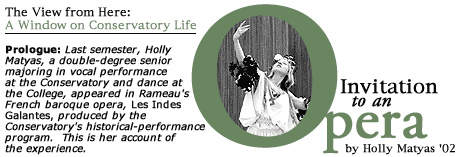

 An audition announcement for Rameau's French Baroque opera Les Indes Galantes, handed to me by my voice professor, Daune Mahy, seemed irresistible – the perfect synthesis of my love for ballet, opera, and the French language. I met with Kenneth Weiss '84, director of the project and visiting assistant professor of harpsichord, to express my enthusiasm and learn more. Only the prologue and act 3, Les Fleurs – without the choruses – would be presented for just one performance in Warner Concert Hall. What made the project so appealing to me were the facts that the Oberlin Baroque Orchestra would accompany and renowned baroque specialists would be part of the production team. Weiss, an exceptional harpsichordist with an extensive background in baroque opera, has worked with Les Arts Florissants as musical assistant to William Christie, with whom he participated in numerous opera productions and recordings. He has also conducted and taught at the Paris Conservatory. Romana Agnel, founder of the historical dance company Ardente Sole and teacher of ancient dance, would arrive from Krakow, Poland, to stage direct and dance a role. Agnes Mellon, professor of singing at the Conservatoire de Caen in France, has performed in such halls as the Paris Opera, Theatre des Champs Elysees, Salle Pleyel, and Carnegie Hall. She would sing the role of Zaire, a slave tormented by love. Despite having to learn an aria with only three days' preparation, I decided to audition. Because competition for singing roles in all Oberlin productions is fierce, after two years at Oberlin I had yet to be cast. I was surprised and delighted then, to see my name on the casting list twice – first as Amour, the mischievous son of Venus, in charge of love, and second as Zaire's understudy. My acquaintance with baroque music was minimal. I was unfamiliar with its harmonic flavors, its dissonance and various ornaments. After several coachings, lessons, and work in the practice room, I memorized most of both roles in time for the intensive week of stagings with Romana Agnel in mid-October. I also took part in a series of baroque dance classes that Agnel conducted that week; some of the students, faculty, and Oberlin town members from her classes were asked to dance in the production. Because Les Indes Galantes is an opera-ballet, dance is very important. My ballet background helped me execute the baroque dance steps, but the style's more relaxed use of the feet and turnout, more dramatic use of the arms, hands, and fingers, and different terminology made the experience a challenging one. Even more challenging was negotiating between the dancing and singing. Amour's movements, which must be light and playful, demanded a high level of energy. After my aria, I immediately danced a short minuet, then jumped into a duet with Hebe, the demi-goddess of youth. Learning and executing the minuet's steps was not difficult; singing the coloratura lines of the duet without a moment to catch my breath definitely was. Although the overall tone of Les Fleurs is light, Zaire's heart is weary; consequently, her movements are as well. She does not dance, but her use of gesture requires the grace of a dancer. Her music is more lyrical than Amour's, and I savored each one of her beautiful melodies. Because I had no public performance as Zaire, I was more motivated than usual to make every rehearsal a performance opportunity. The staging was completed when Agnes Mellon arrived, less than a week before the performance. Because I was also performing in a production of The Nutcracker outside Oberlin, I was unable to participate in the final week of rehearsals. In fact, I had to rush off to dance an afternoon and evening performance of Nutcracker after attending only the first half of the Les Indes Galantes' dress rehearsal. I only learned the complete staging and dancing of Les Fleurs Sunday afternoon – after my final ballet performance and three hours before curtain. Despite the interrupted preparation, I was empowered by the excitement of performing. My aria summoned the maidens to gather their torches while I prepared to defeat Bellone, the demi-god of glory, who had inspired the men to follow him. Victorious, Hebe and I led Bellone's love-struck men off stage. The second half of the performance was even more dynamic. Tacmas, a prince, had disguised himself as a peasant to win the love of Zaire, Ali's slave. Tacmas's own slave, Fatime, disguised herself as a man to sneak into the garden of Ali, with whom she was in love. While these disguises were arranged onstage, I was offstage, gathering flowers for my hair and preparing for my own metamorphoses from Amour to dancer. The conflict between both pairs of lovers resolved, I reappeared, transformed, and with my fellow dancers dressed the stage in flowers to acknowledge their joyous union. The scene backstage after the performance was also joyous. I had been on stage an exhilarating four hours that day and happily welcomed kind words and warm embraces from professors and friends. I cannot wait to do it all again. Epilogue: Holly Matyas landed the role of lead understudy in the Oberlin Opera Theater winter term production of Starbird. She performed the role in outreach performances during the first two weeks of spring semester. |